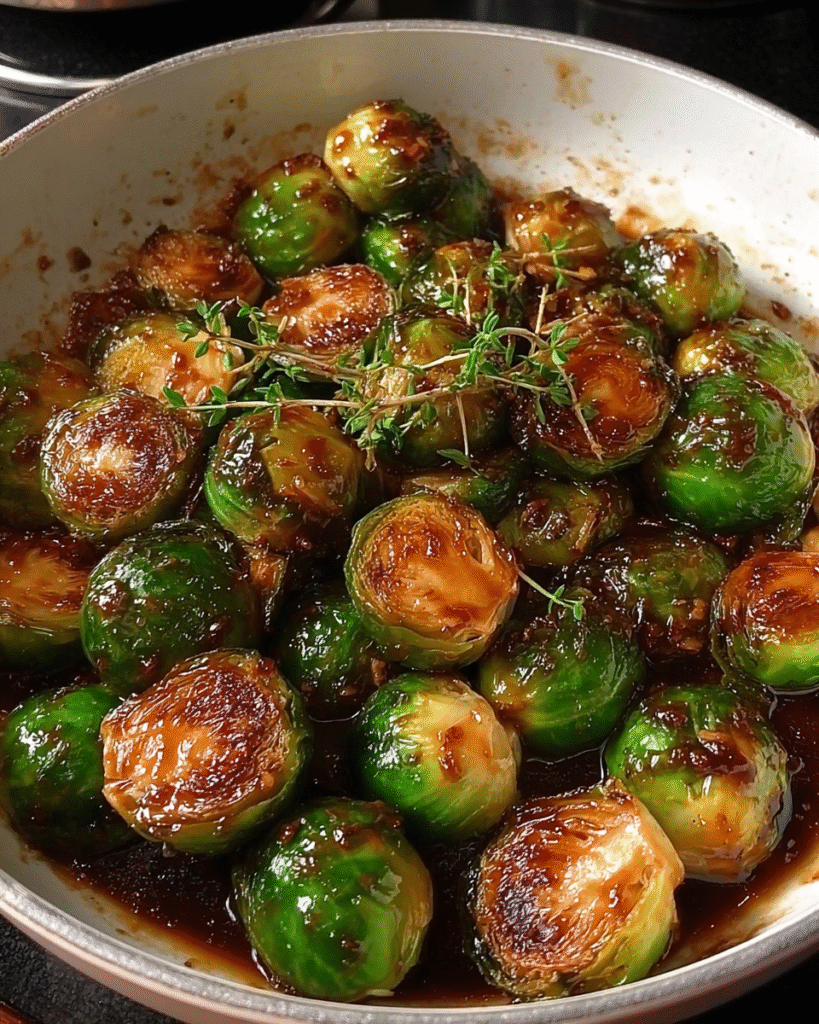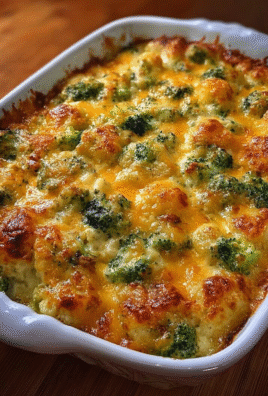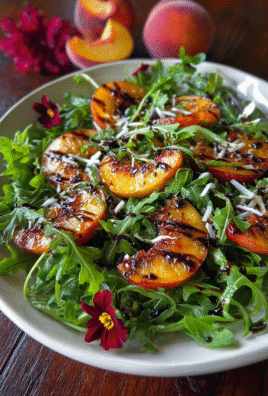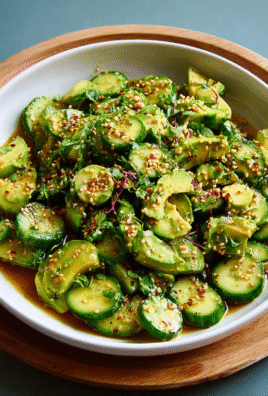
Crispy, golden roasted Brussels sprouts glazed with sweet, tangy balsamic reduction are the perfect harmony of flavor, simplicity, and nutrition. This dish has rapidly become a staple side on dinner tables, offering a vibrant contrast to rich entrées or acting as a star in vegetarian spreads. With just a handful of ingredients and a few simple techniques, this humble vegetable transforms into an elegant, restaurant-worthy side dish.
Whether you’re preparing a cozy weeknight meal, hosting a holiday dinner, or crafting a plant-forward lunch, these sprouts add color, texture, and bold flavor. The secret lies in roasting the sprouts until their outer leaves crisp and caramelize while the insides remain tender. Then comes the glaze—simmered down balsamic vinegar sweetened to perfection—coating the sprouts in a glossy finish that enhances every bite.
The Flavor Magic: Why This Combo Works
Roasting Brussels sprouts changes everything about their flavor. While raw sprouts can taste bitter and dense, roasting them at high heat triggers the Maillard reaction—a chemical process that browns and crisps their surfaces, drawing out natural sweetness and umami depth. The result is a nutty, slightly smoky profile with irresistible texture.
Adding a balsamic glaze introduces a bright, tangy sweetness that cuts through the earthy bitterness of the sprouts. This glaze, reduced slowly to a syrupy consistency, caramelizes lightly when tossed with the hot sprouts. The interplay of crisped vegetables and sticky, dark vinegar creates a flavor profile that balances sweet, sour, and savory in one bite.
The Backstory of Brussels Sprouts and Balsamic Vinegar
Brussels sprouts have been cultivated since the 16th century, with their name originating from Brussels, Belgium, where they were widely grown and consumed. Their dense, leafy heads and sturdy stems made them a winter crop of choice, particularly in colder regions of Europe.
For centuries, they were boiled or steamed, often leaving them mushy and bitter—an unfair fate for a vegetable with such potential. The culinary revival of Brussels sprouts began with roasting techniques that emerged in food trends during the 2000s, transforming them into a crisp, flavorful dish favored by chefs and home cooks alike.
Balsamic vinegar, on the other hand, hails from Modena, Italy. Traditionally aged in wooden barrels, it develops a rich, mellow sweetness balanced by bold acidity. Its luxurious depth makes it a favorite in both savory and sweet applications. The concept of reducing balsamic vinegar to create a glaze started gaining attention in modern kitchens as cooks began exploring condensed, intensified flavors that enhance visual presentation and taste.
The marriage of roasted sprouts with balsamic glaze is a relatively new culinary invention, but it captures the essence of centuries of food evolution—simple, seasonal vegetables elevated through thoughtful technique and powerful seasoning.
Tools and Equipment You’ll Need
A few well-chosen kitchen tools can make the difference between soggy, bitter sprouts and crispy, caramelized perfection. Here’s what you’ll need:
- Baking Sheet or Sheet Pan: Choose a large, rimmed baking sheet that can hold the sprouts in a single layer without crowding. This ensures even browning.
- Sharp Chef’s Knife: Needed for trimming the ends and halving the sprouts uniformly.
- Large Mixing Bowl: For tossing the sprouts with oil and seasonings.
- Saucepan or Small Pot: To reduce the balsamic vinegar into a thick, shiny glaze.
- Tongs or Spatula: For flipping or tossing the sprouts mid-roast.
- Parchment Paper or Silicone Mat (optional): Helps reduce sticking and eases cleanup.
- Whisk or Spoon: For stirring the glaze as it reduces.
Choosing the Right Ingredients
Each ingredient in this recipe plays an essential role. Selecting quality produce and pantry items ensures depth and balance in flavor.
Brussels Sprouts
- Appearance: Look for small to medium sprouts with tight, bright green leaves and no yellowing or brown spots.
- Size: Uniformity matters—try to pick sprouts that are similar in size so they roast evenly.
- Freshness: Choose firm sprouts that feel heavy for their size.
Balsamic Vinegar
- Flavor Profile: Traditional balsamic should be slightly sweet, tangy, and deeply aromatic.
- Quality Tips: Opt for one labeled “Aceto Balsamico di Modena” for authentic flavor.
- Alternate Use: Aged balsamic is typically sweeter and thicker; if using this, you may not need to reduce it as much.
Sweetener for Glaze
- Maple Syrup: A natural sweetener that pairs well with vinegar’s tang.
- Honey: Slightly floral and more viscous.
- Brown Sugar: Adds molasses richness.
- Agave or Coconut Sugar: Vegan-friendly alternatives.
Oil
- Olive Oil: Extra virgin is preferred for flavor, but light olive oil works too.
- Avocado Oil: Neutral and with a high smoke point.
- Other Options: Grapeseed, sunflower, or canola for neutral taste.
Seasonings
- Salt: Enhances caramelization and balances acidity.
- Pepper: Adds mild heat.
- Optional Extras: Garlic powder, smoked paprika, chili flakes, rosemary, or thyme.
Time Breakdown & Recipe Yield
- Preparation: 15 minutes
- Roasting Time: 25 to 30 minutes
- Glaze Reduction: 8 to 10 minutes
- Final Glaze Toss + Rest: 5 to 10 minutes
- Total Time: About 45 to 55 minutes
- Yield: Serves 4 to 6 as a side dish
This dish can be scaled up or down depending on the number of servings required. Simply multiply the ingredients proportionally and use multiple sheet pans to avoid overcrowding.
Preparation Tips for Best Results
- Dry Thoroughly: After washing the sprouts, pat them completely dry. Excess moisture steams the sprouts instead of roasting them.
- Trim Correctly: Remove the dry stem and any outer leaves that are wilted or yellow.
- Halve or Quarter: Depending on the size, halving helps expose the cut side to the heat, which improves browning.
- Use Enough Oil: A light but thorough coating of oil promotes caramelization and prevents dryness.
- Do Not Crowd the Pan: Overcrowding leads to steaming rather than roasting. Leave space between each piece.
- Use High Heat: Roasting at 400°F to 425°F achieves a crisp, browned exterior without overcooking the center.
Step-by-Step Instructions
Step 1: Prep the Brussels Sprouts
- Preheat your oven to 400°F (200°C).
- Wash the Brussels sprouts under cold water.
- Trim the tough stem ends and remove any yellow or loose outer leaves.
- Cut each sprout in half lengthwise.
Step 2: Season and Roast
- Place the halved sprouts in a large mixing bowl.
- Drizzle with olive oil and sprinkle with salt and pepper.
- Toss to coat evenly.
- Spread them cut-side down on a lined or lightly greased baking sheet.
- Roast in the oven for 20–30 minutes until deeply golden and crispy on the edges. Stir or flip once halfway through for even cooking.
Step 3: Prepare the Balsamic Glaze
- In a small saucepan, combine 1/2 cup balsamic vinegar with 1 to 2 tablespoons of sweetener (maple syrup, honey, or brown sugar).
- Bring to a gentle simmer over medium heat.
- Stir frequently and cook until the liquid reduces by half and thickens to a syrupy consistency, about 8–10 minutes.
- Remove from heat and let cool slightly—it will thicken more as it cools.
Step 4: Glaze and Finish
- Once the sprouts are roasted, transfer them back to a clean bowl.
- Drizzle the warm balsamic glaze over the top.
- Toss gently to coat.
- Optional: Return to the oven for another 5 minutes to set the glaze slightly.
- Serve warm, garnished with optional toppings such as chopped nuts, grated cheese, or fresh herbs.
Flavor Variations to Explore
Roasted Brussels sprouts with balsamic glaze are delicious in their classic form, but they’re also an ideal canvas for customization. These variations add depth and adaptability, making the dish suitable for everything from everyday meals to gourmet events.
Sweet & Savory Twists
- Maple Glazed: Substitute or blend balsamic vinegar with maple syrup for an earthy, sweet variation. This works particularly well during fall.
- Honey Garlic: Add minced garlic to the glaze and sweeten with honey for a robust profile that pairs beautifully with poultry and root vegetables.
- Pomegranate Balsamic: Use pomegranate molasses in the glaze or sprinkle pomegranate seeds on top for juicy bursts of tart sweetness.
Spiced and Smoky
- Smoked Paprika: Add a teaspoon of smoked paprika to the oil before roasting. It infuses the sprouts with a smoky aroma.
- Chili-Infused Glaze: Stir in crushed red pepper flakes or a dash of cayenne pepper to the glaze for gentle heat.
- Cumin and Coriander: Add a warm, earthy twist by seasoning the sprouts with ground cumin and coriander before roasting.
Umami Enhancers
- Miso Balsamic Glaze: Whisk a spoon of white miso into the balsamic reduction for a savory depth that’s great in fusion dishes.
- Soy Sauce Splash: Add a dash of soy sauce or tamari for added umami and saltiness in the glaze.
Toppings and Garnishes
- Toasted Nuts: Try chopped pecans, hazelnuts, or almonds for crunch.
- Crispy Bacon or Pancetta: For a salty finish, top with crisped pancetta or bacon crumbles.
- Cheese Shavings: Add crumbled goat cheese, feta, or shavings of Parmesan for creaminess.
- Herbs and Citrus: Finish with fresh thyme, rosemary, or a grating of lemon zest.
Cultural Fusions
- Asian-Inspired: Use sesame oil, soy sauce, and ginger in place of the traditional glaze. Finish with sesame seeds.
- Mediterranean Flair: Roast with oregano, garlic, and olives, then drizzle with a balsamic-laced tapenade.
- Middle Eastern Profile: Add za’atar seasoning and serve with tahini drizzle or sumac for acidity.
Serving Suggestions and Meal Integration
These Brussels sprouts are a flexible side dish that can accompany a wide variety of main courses or be integrated into larger meals.
As a Side Dish
- Meat Pairings: Roast chicken, turkey breast, pork tenderloin, or grilled steak.
- Fish & Seafood: Lemon-herb salmon, shrimp skewers, or cod filets.
- Plant-Based Mains: Stuffed bell peppers, lentil loaves, mushroom steaks, or vegan shepherd’s pie.
In Bowls and Salads
- Grain Bowls: Combine with quinoa, farro, or brown rice, then top with a poached egg and tahini dressing.
- Hearty Salads: Toss into kale or arugula salads with nuts and goat cheese.
- Warm Pasta Dishes: Stir into creamy pasta or serve alongside butternut squash ravioli.
Holiday and Party Appetizer Ideas
- Serve on small skewers as an appetizer.
- Create a “sprouts bar” with various toppings and glazes.
- Use as a pizza topping with roasted garlic and mozzarella.
Nutritional Breakdown and Health Benefits
Roasted Brussels sprouts are not only flavorful—they’re also deeply nourishing. When prepared with a modest amount of oil and a well-balanced glaze, they make a great addition to healthy diets.
Macronutrient Overview (Per Serving)
- Calories: ~150–220
- Fat: 7–12g
- Protein: 3–4g
- Carbohydrates: 12–20g
- Fiber: 4–5g
- Sugar: 5–10g (varies by glaze)
- Sodium: 100–200mg (depends on added salt and soy-based additions)
Key Vitamins and Minerals
- Vitamin K: Supports bone health and blood clotting.
- Vitamin C: Enhances immunity and collagen production.
- Folate: Essential for DNA synthesis and cell growth.
- Fiber: Promotes digestion and supports gut health.
- Antioxidants: Protect against oxidative stress and inflammation.
Glaze Considerations
- Traditional balsamic vinegar contains natural sugars and no fat, but reducing it intensifies its sweetness.
- Sweeteners like honey or maple add carbs and sugars, so portion sizes can be moderated if needed.
- Low-glycemic or alternative sweeteners (like stevia or monk fruit) can be used to reduce sugar content.
Common Mistakes and How to Avoid Them
Brussels sprouts are often misunderstood because poor preparation techniques can lead to bitterness, sogginess, or a lack of flavor. Avoid these common mistakes for optimal results.
Overcrowding the Pan
Problem: Overcrowding leads to steaming instead of roasting, making the sprouts soggy.
Solution: Spread the sprouts in a single, even layer with space between each half. Use two pans if necessary.
Roasting at the Wrong Temperature
Problem: Low oven temps won’t achieve crispness. High heat can burn without caramelization.
Solution: Roast at 400°F to 425°F. Start checking after 20 minutes. Toss halfway through for even browning.
Not Drying the Sprouts
Problem: Wet sprouts from washing lead to soft or uneven roasting.
Solution: Pat dry thoroughly with a kitchen towel or use a salad spinner before seasoning.
Adding Glaze Too Early
Problem: Sugars in the glaze can burn during roasting, resulting in bitter notes.
Solution: Always add glaze at the end of roasting or after cooking. A final toss or light drizzle preserves the flavor.
Using Poor Quality Balsamic Vinegar
Problem: Harsh, acidic vinegar can overpower the sprouts.
Solution: Use a mid-to-high-quality vinegar. If it tastes too sharp, simmer with a little sweetener to mellow it out.
Neglecting Salt and Seasoning
Problem: Under-seasoned sprouts can taste bland despite the glaze.
Solution: Season generously with salt and pepper before roasting. Salt enhances caramelization and brings out natural flavors.
Advanced Techniques for Restaurant-Quality Results
Perfecting roasted Brussels sprouts with balsamic glaze is all about fine-tuning technique and maximizing flavor at each step. These advanced strategies elevate the dish from simple side to culinary standout.
Preheating the Sheet Pan
For extra caramelization, preheat your empty sheet pan in the oven for 10 minutes before adding the sprouts. The initial sizzle creates a golden crust on the cut sides, similar to a sear.
Scoring Large Sprouts
If your sprouts are larger than average, consider scoring an X into the stem base or quartering them. This helps them cook evenly and prevents a raw center while achieving crisp outer leaves.
Roasting on Convection Setting
Using a convection oven, or a convection setting, circulates hot air more evenly. This accelerates browning and crisps sprouts faster. Reduce oven temperature slightly when using convection.
Double-Roasting with Glaze
Try roasting the sprouts twice—first dry, then again after tossing them in the balsamic glaze. The second roast helps the glaze adhere and caramelize slightly for a stickier, more flavorful finish.
Dry Toasting Nuts Separately
To keep nuts like pecans or almonds crunchy when added to the dish, toast them separately in a dry skillet. Then stir them in at the end, preserving their texture.
Cold Glaze Application
Chilling the glaze before applying it to warm sprouts can create a glossy coating that sets faster and adds a visual pop to your presentation.
Storage, Reheating & Meal Prep Tips
This dish stores well and can be adapted for weekly meal prep, leftover management, or make-ahead events. With proper storage, you can enjoy crispy sprouts even days later.
Refrigeration
Cool completely before storing. Transfer to an airtight glass or plastic container. Store for up to four days in the refrigerator. Avoid stacking multiple layers to maintain crispiness.
Reheating Methods
- Oven Method: Preheat to 400°F. Spread sprouts on a baking sheet and roast for 5–10 minutes until heated and crisped.
- Air Fryer: Heat at 375°F for 3–5 minutes, shaking halfway through.
- Stovetop: Heat in a dry skillet over medium heat for 5 minutes, stirring occasionally.
- Microwave: Use only if necessary. Place on a paper towel and microwave in short bursts to avoid sogginess.
Freezing
Freezing is not recommended due to water content, which affects texture upon thawing. However, you can freeze raw, trimmed sprouts and roast them from frozen later (add extra time).
Meal Prep Integration
- Base for Bowls: Add to quinoa, rice, or couscous for a lunch bowl.
- Wraps & Pitas: Use as filling with hummus or grilled veggies.
- Mixed Roasts: Combine with roasted carrots, squash, or cauliflower for colorful medleys.
Frequently Asked Questions (FAQs)
Can I use frozen Brussels sprouts?
Yes, but they need special handling. Roast them directly from frozen at a high heat to evaporate moisture quickly. Avoid thawing first, as that leads to sogginess. Expect less crispness compared to fresh.
What’s the difference between balsamic vinegar and balsamic glaze?
Balsamic vinegar is a thin, acidic liquid aged from grape must. Balsamic glaze is a reduced version, thickened through simmering—often with added sweeteners. Glaze is more intense and syrupy.
Is this dish vegan and gluten-free?
Yes, it’s naturally gluten-free and can be vegan if you use maple syrup or agave in the glaze. Always check sweetener labels for additives if dietary restrictions are strict.
How do I make it oil-free?
Instead of oil, use a small amount of vegetable broth or lemon juice for roasting. Expect slightly less crispiness, but flavor remains strong. Use parchment to prevent sticking.
Can I prepare it ahead of time?
Absolutely. You can roast the sprouts and make the glaze a day in advance. Store them separately. Reheat the sprouts in the oven and warm the glaze slightly before combining.
Can I batch cook this for events?
Yes, just use multiple trays and rotate them in the oven halfway through. Don’t overcrowd. Keep the glaze warm and apply it to each tray as it finishes roasting.
How do I make the glaze without added sugar?
Use aged balsamic vinegar, which is naturally sweeter. Alternatively, reduce standard balsamic vinegar longer until thick without adding sweeteners. You may also add a few mashed dates or prune puree for natural sweetness.
How can I keep the sprouts crispy?
Dry thoroughly before roasting, use a hot oven, and space them well on the sheet pan. For storage, avoid sealing them while hot to prevent steam buildup.
Can I serve these cold or room temperature?
Yes. They work well in room-temp salads or antipasto platters. If serving cold, add a fresh drizzle of glaze and a sprinkle of herbs for brightness.
What pairs best with these sprouts?
Roasted meats, grilled fish, mashed potatoes, creamy pastas, lentil loaf, risottos, or warm grain salads. Their sweet-savory flavor bridges well with rich or earthy mains.
Presentation & Garnishing Ideas
Serving roasted Brussels sprouts with style enhances the experience and elevates their perceived value. Whether you’re plating for family dinner or a formal gathering, presentation matters.
Garnish Ideas
- Color: Brighten with pomegranate seeds, lemon zest, or chopped parsley.
- Texture: Add toasted pine nuts, almonds, or pepitas.
- Creaminess: Dot with goat cheese, feta, or a dollop of Greek yogurt.
- Contrast: A drizzle of tahini, aioli, or yogurt-based sauces offers creamy contrast.
Serving Styles
- Family Style: Heap them on a rustic platter with scattered herbs and glaze drizzle.
- Individual Plates: Serve a small stack or fan of sprouts beside the main course.
- Bites: Skewer small sprouts on toothpicks and drizzle with glaze for appetizers.
- Salad Toppers: Toss over arugula or kale with vinaigrette for an elevated side.
Conclusion
Roasted Brussels sprouts with balsamic glaze represent everything we love about great food—simple ingredients, big flavor, and the power of technique. With a hot oven and the right glaze, these once-maligned vegetables become the highlight of any plate. Their versatility makes them as welcome at holiday feasts as they are in quick weekday meals.
More than just a side dish, they reflect the balance of taste and texture that defines excellent cooking: crispy, tender, sweet, and tangy. With endless ways to tweak and adapt the recipe, you can make this dish your own every time. Whether roasted solo, paired with proteins, or tossed into bowls, they offer comfort, nutrition, and bold flavor in every bite.
Experiment with flavors, adjust to your pantry, and enjoy the transformation from ordinary to extraordinary—one sprout at a time.




Leave a Comment